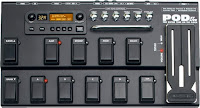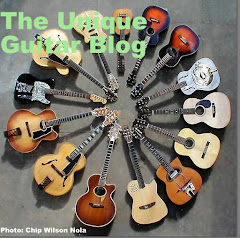 |
| Marcus Ryle & Michael Doidic 1985 |
Marcus Ryle, and Michel Doidic were acoustic engineers and designers that worked for the synthesizer manufacturer Oberheim. They eventually went on to co-founded their own company called Fast-Forward Design, and used their talent for other organizations.
 |
| Alexis Quadraverb |
One of these was the Alesis Company. They used their engineering knowledge to design and create the Alesis ADAT, and the Quadraverb, QuadraSynth, and Digidesign SampleCell.
All of these products utilized digital signal processing integrated circuitry.
So by the late 1980’s they turned their sights to DSP based guitar products. As Marcus Ryle says in an interview, DSP chips had become affordable enough to be utilized for guitar amplifiers and effects.
 |
| Ryle & Doidic - The Fast Forward Co. |
Line 6 has created so many innovated products, and has become a a major player in the guitar industry. Like so many other successful start-up businesses, large corporations take note. On December 20th, of 2013 Line 6 was acquired by the Yamaha Corporation in an agreement that provided benefits for the original company and founders, as well as Yamaha. Under the contractual guidelines Line 6 would remain a wholly owned subsidiary.
 |
| Original Line 6 Spider 112 |
I have already written about the revolutionary amplifiers, this company has produced. Let us now take a look at the other innovative products Line 6 has created.
 |
| 1998 Line 6 POD |
The POD was the original stand-alone DSP device, and was copied by several other companies.
 |
| 2000 POD 2.0 |
It consisted of a pre-programmed E-Prom chip, and a do-it-yourself instructions to back up the users presets, and change out the chip to the new chip.
 |
| 2000 Bass POD |
This same year the Bass POD was introduced. It had 16 bass amp models, 16 bass cabinets, and 16 different effects.
Both the POD 2.0 and the Bass POD were introduced in 2000 as in rack mountable formats.
 |
| 2001 Chrome POD 2.0 |
In 2001 Line 6 came out with a limited edition chrome version of the POD 2.0.
 |
| 2002 Line 6 PODxt |
By 2003 Line 6 offered the rack mountable POD XT Pro.
Also this year the Bass PODxt and the rack mountable Bass PODxt Pro were offered.
 |
| 2004 Line 6 PODxt Live |
It included a dedicated digital input for the Variax instruments.
 |
| 2005 Line 6 Bass PODxt Live |
The next year, 2005, a bass version called the Bass PODxt Live was launched.
 |
| 2006 Floor POD |
In 2006, the more affordable Floor POD was introduced. This had the same great tones as the POD 2.0, included 12 amp models, and an expression pedal.
 |
| Line 6 POD X3 |
 |
| Line 6 HD 300-400-500 |
Fast forward to 2010 for the introduction of the POD HD 300, 400, and 500 models. These were floor model units.
 |
| Line 6 POD HD Pro |
The POD HD Pro was introduced in 2011. It was a rack mounted device.
 |
| Line 6 POD HD 500X |
In 2013, two more POD devices were offered. The POD HD 500X was a floor unit with all the effects found in the POD 500, but with the addition of LED foot switches, and enhanced features.
 |
| Line 6 POD HD Pro X |
The POD HD Pro X was a rack mounted unit and an enhanced version of the POD HD.
 |
| Line 6 DL4 |
 |
| Line 6 MM4 |
 |
| Line 6 FM4 |
 |
| Line 6 AM4 |
The AM4 was a a pedal that offered 16 different amp models.
 |
| Line 6 Echo Park |
It was not until 2004 that Line 6 came out with a series of stomp box style pedals. The Echo Park featured differing versions of useful delays.
 |
| Line 6 Uber Metal |
The Uber Metal produced hi-gain over driven tones.
 |
| Line 6 Tap Tremolo |
The Tap Tremolo featured an array of tap adjustable tremolo and stereo panning effects.
 |
| Line 6 Constrictor |
The Constrictor featured models of guitar compressor pedals from the 1960’s to the 1980’s.
 |
| Line 6 Space Chorus |
The Space Chorus modeled vintage and modern chorus and vibrato effects.
 |
| Line 6 Liqua Flange and Dr. Distorto |
2005 brought out new pedals such as the Liqua Flange, and the Dr. Distorto pedal that featured classic distortion tones, as well as sustain and harmonic feedback.
 |
| Line 6 Otto Filter |
The Otto Filter pedal produced an auto-wah effect, as well as band pass and low pass sounds.
 |
| Line 6 Roto Machine & Verbzilla |
The Roto Machine featured a rotary speaker effect, and the Verbzilla pedal emulated classic reverb sounds.
 |
| Line 6 JM4 Looper |
It also came with 100 preset songs, instrument and mic inputs, an a SD card slot for exporting files.
 |
| L6 ToneCore Developer |
 |
| Line 6 M13 Stompbox Modeler |
2008 also brought the M13 Stomp box Modeler which offered over 100 classic and new distortions, delays, reverbs, and modulation effects with a 28 second looper.
 |
| Line 6 M9 Stompbox Modeler |
In 2009 the Line 6 M9 Stompbox Modeler was introduced. This floor effect box feature 75 effects and a 28 second looper and was a smaller version of the M13.
 |
| Line 6 M5 Stompbox Modeler |
2011 was the year that Line 6 came out with the M5 Stompbox Modeler. This floor effect offered 100+ effects with a 24 second looper and an expression pedal.
 |
| Line 6 Helix |
One of the most interesting products Line 6 developed was the Variax, which first surfaced in 2002.
 |
| Line 6 Variax 500 |
 |
| Variax 700 |
In 2003, the Variax 700 was introduced in a hard tail and tremolo version. These were upgraded models. The Variax 700 had all the features of the model 500, but had a contoured mahogany body with a carved ash top, bone nut, and pearl inlays. The Variax 700 came with these same features, but included a L.R. Baggs tremolo bridge.
 |
| Variax 700 Acoustic |
In 2004, Line 6 introduced the Variax Acoustic model, which was a thin body acoustic instrument that emulated 16 classic acoustic models, including steel and nylon string, 12-string, jazz and resonator guitars, a banjo, mandola, sitar and the 3 stringed Japanese shamisen; all that, plus alternate tunings, position controls, and a built-in compressor.
 |
| Line 6 Variax 700 Bass |
 |
| Variax 300 |
By 2005 the Variax 300 was offered as an affordable electric guitar version of the Variax line.
 |
| Variax 600 & 705 Bass |
Also offered this year were the Variax 600 and the Variax 705 five string bass.
 |
| Line 6 Variax 300 Acoustic |
2006 brought about the Variax Acoustic 300 Steel and Acoustic 300 Nylon, which were more affordable versions of the acoustic model DSP guitars.
 |
| JTV - 69 |
In 2010 Line 6 teamed up with luthier James Tyler to design the James Tyler JTV-69, JTV-89, and the JTV-59 guitars which all included DSP modeling.
 |
| Line 6 JTV-69 |
2012 brought the Line 6 James Tyler JTV 59-P, which was based on a Les Paul body design. This guitar came in gold-top or black finishes, and had twin "soap bar" pickups in addition to the Variax features.
 |
| 2012 JTV -69P |
Also this year Line 6 offered the James Tyler JTV 69-P, which was based on a Stratocaster body with a tremolo and 3 single coil pickups.
 |
| JTV 89-F |
In 2013 the James Tyler JTV 89-F was offered. It was based on a super-strat, and had a licensed Floyd Rose tremolo system along with the Variax capabilities and the Line 6 brought the Variax Standard, which was not under the James Tylyer banner. This was a Stratocaster style guitar with the Variax features.
 |
| Line 6 Limited Edition Emerald |
In 2016 the Variax Limited Edition Emerald edition of this same guitar. The following year, the Variax Limited Edition was issued in Amethyst as a result of a contest for a new color.
 |
| 2018 Limited Edition Onyx |
In 2018 the Variax Onyx Limited Edition was unveiled.
Due to Yamaha's acquisition two other Variax models were produced. In 2017 the Shuriken Variax SR270 became available due to a collaboration between Yamaha and Shuriken guitars.
 |
| Line 6 Shuriken SR270 Variax |
This guitar had a unique shape and a 27" scale and came with Variax HS technology. In 2018 this guitar was redesigned to have a more manageable 25.5" scale.
Click on the links below the pictures for sources. Click on links in the text for further information.
©UniqueGuitar Publications (text only)




















